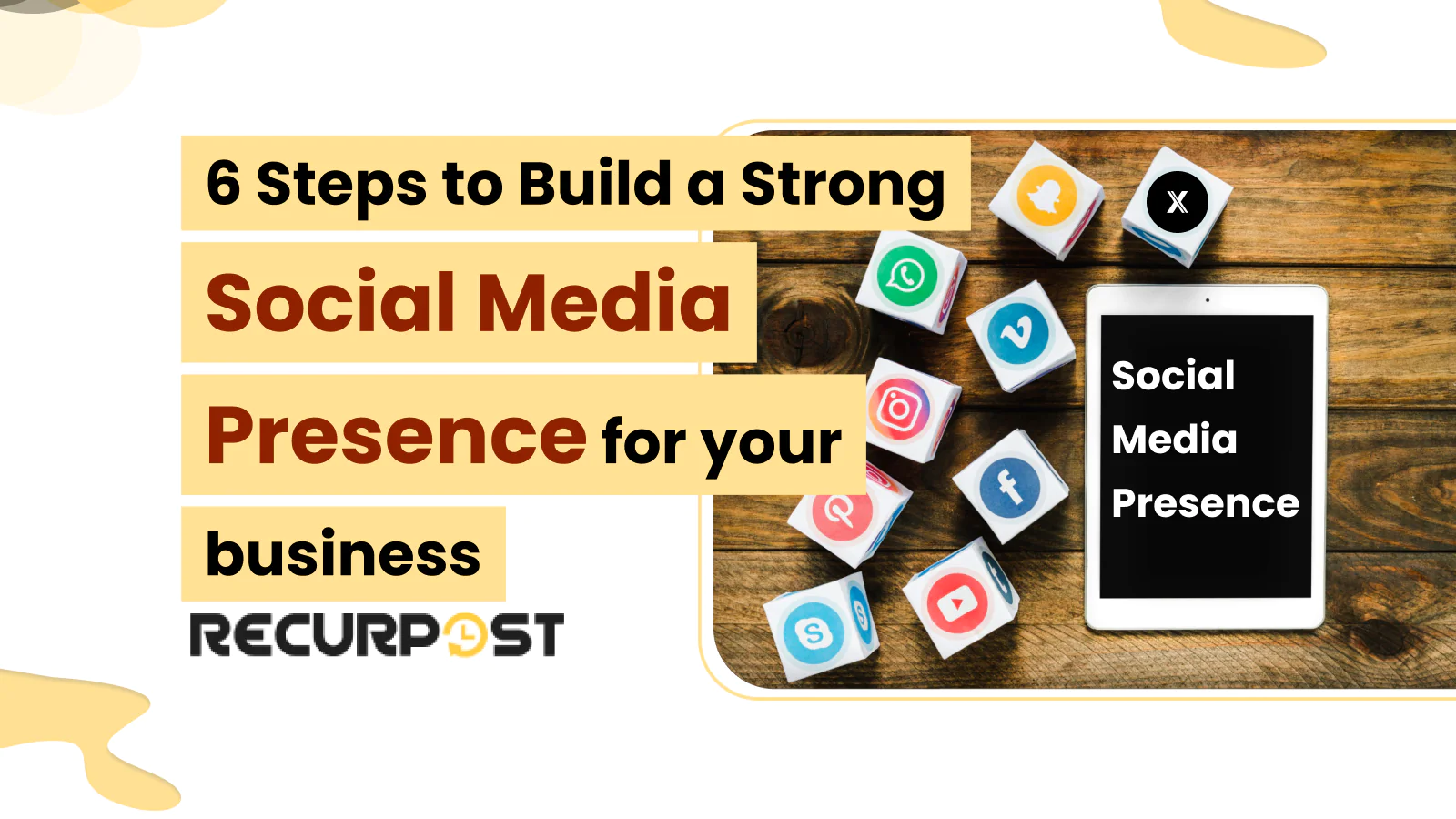Building a strong social media presence for your business calls for clear direction. Many small business owners post daily yet remain unseen, gaining no traction, attracting no new customers, and relying on guesswork. Managing different platforms and shifting trends often leaves them asking:
Am I even building my social media presence right?
Here’s a stat that shows why your Social Media Presence matters:
78% of buyers say they’re more likely to purchase from a brand they follow on social media. So yes, being active online matters. But just showing up on social media isn’t enough to build a strong social media presence. RecurPost has already supported over 100,000 small businesses in building a stronger online identity, standing out from the crowd, and turning followers into loyal customers.
This blog shares six clear steps to grow your social media presence and:
- Show up on your social profile with confidence
- Attract the right target audience on your social account
- Build a real digital social footprint that drives business results
Choose a niche, build a portfolio, and register your business. Offer content creation, scheduling, and analytics packages to win clients and grow as a social media marketing agency. A strong social media presence earns attention from your audience and gets noticed by competitors.
What is Social Media Presence?
Social media presence is your brand’s full digital footprint across platforms. It covers visual identity, brand voice, and engagement habits that shape recognition and trust.
Building a strong social media presence sets the stage for growth. It goes beyond keeping accounts and shapes your online identity.
Social media presence is more than just accounts on Instagram, Facebook, or LinkedIn. Real presence means steady social content, active audience engagement, and driving results like stronger engagement rates and conversions.
Social media presence acts as your brand’s online identity. It shares values, builds connections, and drives customer actions through posts, comments, and interactions.
Social Media Presence works as your brand’s online identity. It communicates values, builds connections, and drives customer actions through posts, comments, and interactions.
Your social media presence is the digital persona of your brand that audiences experience across all platforms.
What Does a Successful Social Media Presence Include?
A successful social media presence comes from several parts that create a unified brand experience, draw your target audience, and spark lasting relationships:
Profile Setup
This covers your bio, profile photo, cover image, and link in bio. It’s the first thing people see, so keep it clear and aligned across platforms.
Social Content
Social content covers posts, stories, videos, and captions that reflect your brand voice. Do you teach, entertain, share tips, or celebrate customers? These choices set your content themes and shape your visual identity.
Engagement Habits
Engagement habits cover replying to comments, answering DMs, and giving feedback. These actions show a real human behind the account and boost your engagement rate.
Step 1: Define Your Brand Voice & Visual Identity
Have you ever scrolled past a brand’s page and thought: “Wait… is this the same business I saw yesterday?” That kind of confusion weakens your social media presence.
This happens when visuals change every post or brand voice flips from quirky to corporate. Steady style builds recognition, trust, and audience recall, boosting your digital footprint.
Defining brand voice and visual identity removes guesswork and creates authentic connections. This is what separates a strong social media presence from ordinary accounts.
What is Brand Voice?
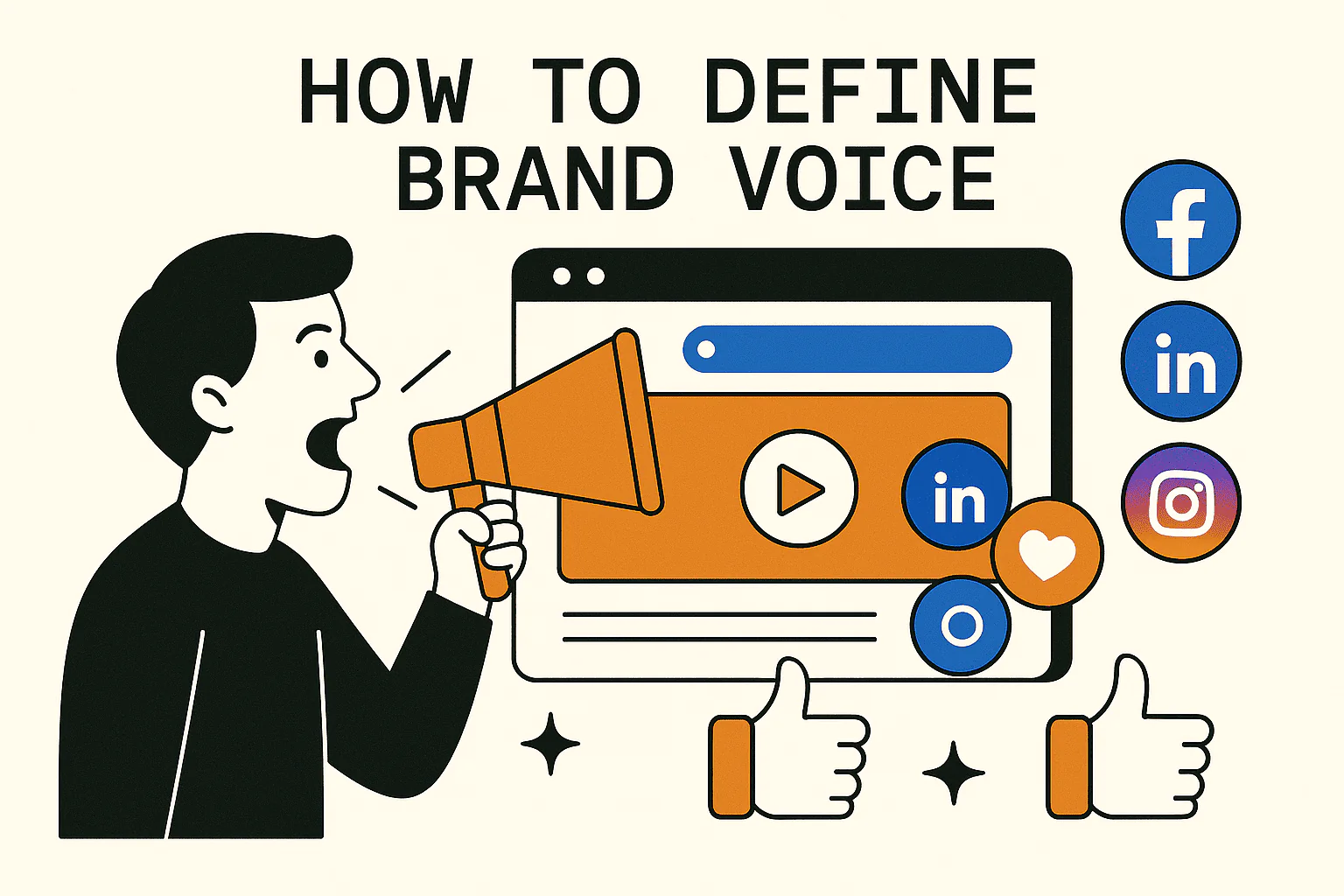
Brand voice is the tone, style, and personality your business uses to connect with the audience. It shapes online identity and shows how your brand communicates with people.
Brand voice answers:
- Should your tone on social profiles be casual or formal?
- Do you use emojis and humor on your social media, or keep it more serious?
- Does your brand’s social content sound more like a friendly guide or a bold expert?
Applying a clear brand voice across captions, DMs, stories, replies, and visuals builds familiarity and strengthens engagement habits.
To Define Your Brand Voice on social media, ask
- How do my customers talk?
- What vibe fits best: friendly, bold, quirky, smart?
- What tone matches my product or service?
Quick Tip: Pick 3 words (e.g., relatable, confident, minimal) to guide your content themes and keep your social media presence steady.
Understand brand voice and social media presence through the example of Nike:
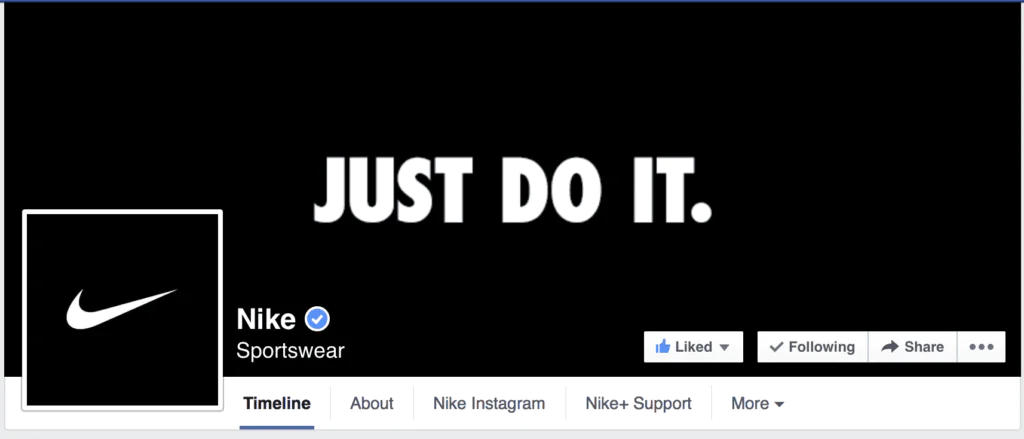
Nike targets athletes and active people, so its voice is bold, motivational, and action-driven, which strengthens its social media presence through slogans like “Just Do It” and “You Can’t Stop Us.”
These slogans spark confidence and determination. Each message reflects Nike’s identity, motivating its audience and reinforcing engagement habits that grow loyalty.
What is Visual Identity?
Visual identity sets your brand’s look across platforms and shapes how the audience sees you.
People notice visuals before text in a fast-scrolling social media feed. Clean, steady branding boosts engagement rate, while random visuals weaken your digital footprint.
Visual Identity’s Importance on Social Media

- It builds social recognition. People can spot your content even without your name.
- It adds polish: A clean, steady feed builds trust.
- It speeds content creation: No guesswork, you know how each post should look.
- It shows brand personality without words.
Core Parts of a Visual Identity
Color Palette
Choose 2–4 colors that match your brand’s social personality. Use them across posts, Stories, Highlights, and ads
- Soft, neutral tones create a calm, simple look that gives lifestyle brands a polished social media presence.
- Bright, bold colors bring energy and youthfulness to your brand, helping your social media presence stand out in feeds.
- Dark, monochrome shades give premium, luxury, tech, and corporate brands a sleek, modern social media presence.
Strong palettes create a recognizable look and strengthen your social media presence.
Fonts
Choose one heading font and one body font that reflect your brand vibe.
- A fun DTC brand might use playful sans-serif fonts
- A finance coach might prefer a clean serif font to project authority and build a trustworthy social media presence.
Fonts reinforce visual identity and keep your social media presence aligned.
Logo and Icon Style
- Decide logo placement: bottom corner, centered, or top, and keep it steady across posts.
- Use the same logo version across all posts to keep your branding steady and strengthen your social media presence.
A clear logo style strengthens brand recall within your social media presence.
Photography Style
Are your photos bright and real, or moody and styled?
- A café might use natural lighting and lifestyle shots.
- A tech brand may lean into refined product images.
Your photo style speaks before words and defines visual identity.
Post Layout and Templates
- Use steady templates for quotes, announcements, testimonials, and updates.
- Create a “grid style” for Instagram, mixing rows of content and branded text overlays.
- Use Canva’s free Brand Kit to store your logo, fonts, and colors in one place for quick posting.
Templates save time and keep your social media presence visually aligned.
Understand visual identity through the example of Nike:
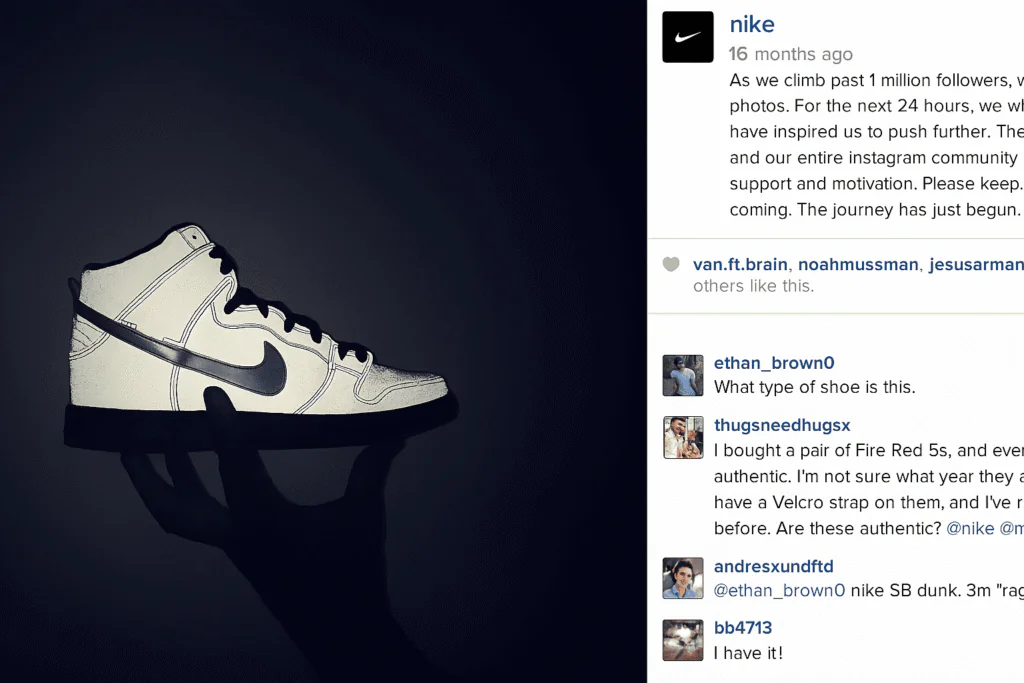
Its visual identity is bold and instantly recognizable, aligned with brand voice. The Swoosh logo, black-and-white scheme, and athlete imagery reinforce Nike’s digital persona of energy and determination.
Nike uses high-contrast photos, bold fonts, and dynamic layouts. Across billboards, Instagram posts, or packaging, every visual reinforces its social media presence and message of pushing limits.
Quick-Start Table: Build Your Brand Identity
| Task | Why It Matters | Tool | Time Needed |
| Define brand color palette | Sets tone and builds visual consistency | Coolors.co | 10 mins |
| Choose 2 brand fonts | Adds clarity and recognition to posts | Fontpair.co | 5 mins |
| Create branded templates | Speeds up content creation and enforces brand look | Canva | 30 mins |
| Build a brand kit | Keeps brand assets in one place | Canva / Google Drive | 10 mins |
| Review the Instagram feed layout | Spot inconsistencies in tone and flow | Phone / Screenshot | 5 mins |
Common Mistakes to Avoid in Building your Social Media Presence
- Using different filters or random colors in every post
- Relying on random Canva templates with no set design flow
- Posting stock photos that clash with your brand voice
- Copying competitors instead of shaping your own digital persona
- Ignoring layout flow, especially on Instagram, where visual identity counts the most
You’re now ready to show up with a steady social media presence, and that’s how trust begins.
Step 2: Pick the Right Platforms for a Stronger Social Media Presence

Platform selection beats spreading everywhere. Trying to cover all platforms without direction weakens your social media presence. Choosing 1–2 strong channels creates better results.
Now you’re equipped not just with a plan, but with proof that your social media presence truly works y. Picking platforms where your audience is most active builds a stronger digital footprint than a scattered media presence.
Updated Platform Demographics & Trends (2025 Snapshot)
| Platform | Primary Audience | Trending Content | Notes |
| 18–34 | Reels, carousels, UGC | Still strong for lifestyle, fashion, wellness, and creators | |
| 25–34 | Groups, events, and community posts | Best for local services, parenting, and home improvement | |
| 30–50 | Thought leadership, industry tips | Top for B2B, personal branding, lead gen | |
| TikTok | 16–30 | Short videos, challenges | Fast-growing for e-commerce and entertainment |
| 25–44 (70% female) | Pins, how-to guides | Excellent for DIY, beauty, recipes, fashion | |
| YouTube | 18–49 | Long-form, educational, vlogs | Searchable and long shelf life for video content |
| X (Twitter) | 25–45 | Real-time opinions, updates | Tech, startups, breaking news |
Instagram – Statista
Facebook – Statista
LinkedIn – Data reportal
TikTok – Backlinko
Pinterest -DataReportal
YouTube – DataReportal
X (Twitter) – Statista
Decision Matrix: Platform Fit by Business Type
“Not every channel supports your Social Media Presence equally” –>“Not every channel strengthens your social media presence equally.”
| Business Type | Best Platforms | Why It Works |
| Local Bakery | Instagram, Facebook | Visual content + community engagement |
| Online Coach | Instagram, LinkedIn, YouTube | Personal branding + long-form content |
SaaS Startup | LinkedIn, Twitter, YouTube | B2B thought leadership + product explainers |
| Fashion Brand | Instagram, TikTok, Pinterest | Style-driven content + trend discovery |
| Home Decor Brand | Pinterest, Instagram, YouTube | Visual how-tos + product inspiration |
| Fitness Trainer | Instagram, TikTok | Lifestyle reels + daily inspiration |
Real-World Examples
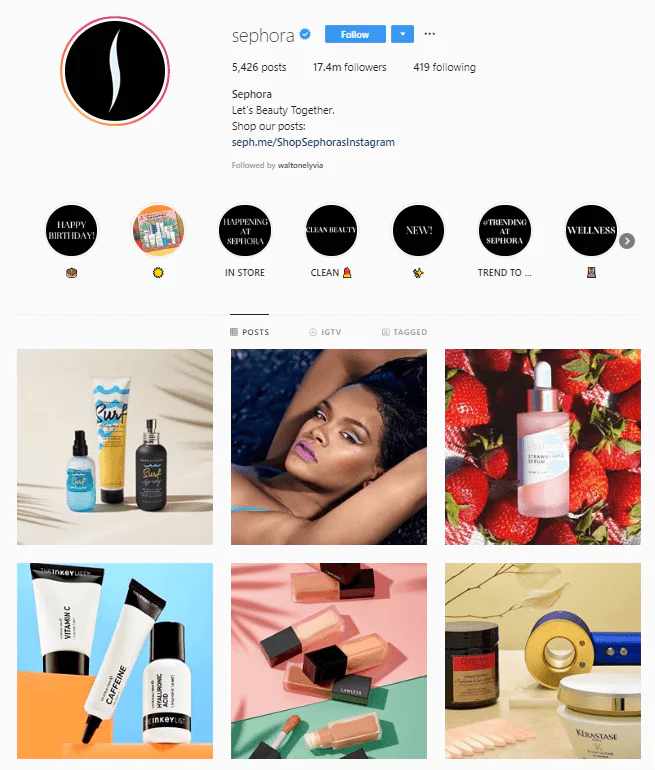
Sephora strengthens its Social Media Presence with Instagram and TikTok to reach Gen Z and Millennials. They use visual-rich showcases, influencer partnerships, and user-generated content to build trust.
Match Your Goals to the Right Platform
| Goal | Platform Match | Rationale |
| Build brand awareness | Instagram, TikTok | Great organic reach through Reels and trends |
| Drive traffic to website/blog | Pinterest, LinkedIn | Searchable content, link support |
| Generate leads | LinkedIn, Facebook | Lead forms + targeting tools |
| Sell products | Instagram, Pinterest, TikTok | Integrated shops and creator features |
| Build a community | Facebook Groups, Discord, Instagram Close Friends | Community tools and DM engagement |
Emerging Platforms to Watch
- Lemon8 – Gaining traction among Gen Z and lifestyle creators
- Threads – Growing for quick updates.
- YouTube Shorts – rising competitor to TikTok.
Watch these platforms, but don’t join until you can maintain them and create the right content formats for a strong social media presence.
Common Mistakes to Avoid
- Jumping on every platform just because it’s trending
- Reposting duplicate social content everywhere
- Ignoring your target audience
- Not adapting content formats (text ≠ Reels)
- Tracking vanity metrics instead of conversions.
Step 3: Build a Content Plan
A clear plan prevents random posting or inactivity. A content plan answers: What will you post, when will you post it, and why? This creates steady social content that supports your content plan and strengthens your social media presence.
This simple structure saves time, reduces stress, and keeps your brand voice steady. That steadiness strengthens your social media presence.
1. Choose 3 to 5 Content Themes (also called Content Pillars)
Content themes define your main topics, shaping your digital footprint and keeping your social media presence aligned.
Example (for a wellness coach):
- Simple workout tips that strengthen your fitness brand’s social media presence.
- Healthy recipe ideas that align with your social presence.
- Stories from clients will help strengthen your social media presence.
- Behind-the-scenes posts that build engagement and increase your social media presence.
- Special offers or promotions for increasing your social presence,
These pillars guide your content mix and give your social media presence a steady rhythm.
2. Mix Up Your Content Types
Audiences follow brands for content variety rather than repetition or randomness.
Here’s a simple mix to follow for increasing social media presence:
| Type of Post | What It Does | How Often to Post |
| Educational | Teaches your audience something useful | About 40% |
| Entertaining | Makes them smile or relate | About 30% |
| Promotional | Sells your product/service | About 20% |
| Community-based | Involves your audience (shout-outs, UGC) | About 10% |
This helps you build trust with your audience before you sell.
3. How Often Should You Post?
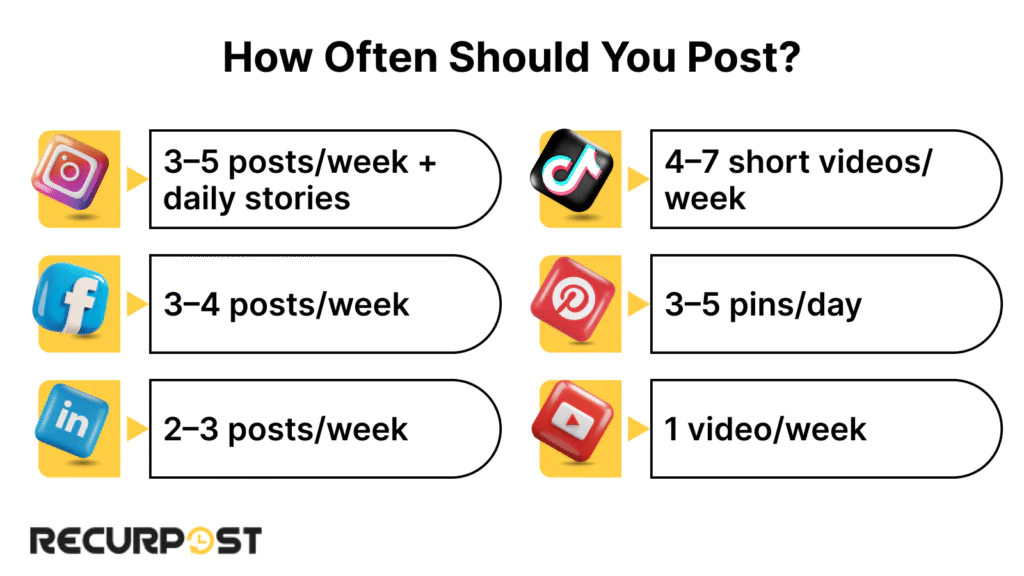
Posting frequency matters more than volume. A steady rhythm strengthens your social media presence and builds audience trust.
Use the RecurPost Social Media Bulk Scheduler to plan, post consistently, and save hours each week.
4. Plan Your Week with a Simple Content Calendar
A content calendar shows what you’ll post each day. It organizes your content and prevents last-minute stress, while strengthening your social media presence.
Understand it with an Example (for Instagram):
- Monday: Motivational quote
- Tuesday: Quick tip or carousel
- Wednesday: Customer story
- Thursday: Behind-the-scenes video.
- Friday: Product highlight or special offer
Use this as a template for all platforms. A weekly calendar saves time and brings structure to your social media. Tools like Google Sheets, Notion, or RecurPost help plan and schedule posts, making your social media presence steadier.
Real Example: Duolingo on TikTok
Duolingo went viral by posting funny, relatable videos on social media with its owl mascot.
They don’t just sell language lessons on social media; they:
- Follow trends
- Use humor to connect with Gen Z
- Post regularly with a clear, fun tone
The result? Huge brand love and high engagement, with zero hard selling.
Tools to Make Planning Easier for a Stronger Social Media Presence
- RecurPost – Posting schedule, reuse high-performing ones, and plan your calendar in advance
- Canva – Design branded posts, templates, and stories
- Google Calendar/Notion – Organize your weekly or monthly plan to maintain a steady social media presence.
- Pexels/Unsplash – Free, legal images
Avoid These Mistakes while Building your Social Media Presence
- Posting only when you feel like it
- Being too sales-heavy too often
- Ignoring analytics
- Posting too much or too little without a steady rhythm
- Missing seasonal events or campaigns hurts your social media presence and audience engagement.
Step 4: Engage Meaningfully With Your Audience
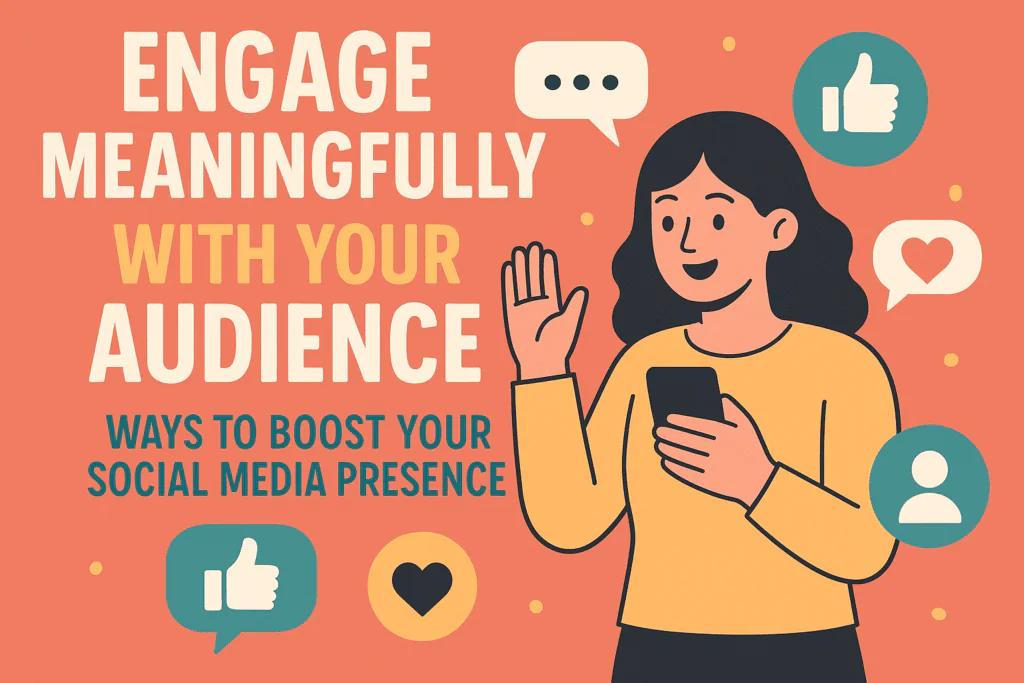
Why Engagement Builds Trust
A strong social media presence works as a two-way conversation, not one-way broadcasting. Posting without interaction weakens your engagement habits.
Engagement makes social media followers feel valued and connected. Strong engagement habits build loyalty, raise sales, and strengthen your digital footprint.
Why Social Media Presence Matters (with Stats)
- 76% of consumers say they’re more likely to buy from a brand they feel connected to.
- 71% of users who have a positive experience with a brand on social media are likely to recommend it to others.
- 42% of customers expect a response on social media within 60 minutes.
Quick replies show strong engagement habits and improve customer satisfaction.
Average Response Time Expectations by Platform
These benchmarks reflect how quickly users expect brands to reply to customer service inquiries, direct messages, and public comments on social media:
| Platform | Expected Response Time |
| Within 24 hours | |
| Same business day | |
| Twitter (X) | Within 2 hours |
| Within 24–48 hours | |
| TikTok | Within 24 hours |
| YouTube | Within 1–2 days |
Fast responses raise engagement rate, boost loyalty, and strengthen Social Media Presence.
The Role of Social Listening
Social listening means tracking what people are saying about your brand, competitors, and industry, even without a tag.
It gives you valuable insights to:
- Discover what your audience cares about
- Track brand reputation
- Spot industry trends early
- Strengthen content and customer service
According to Meltwater’s 2024 State of Social Report, brands that actively engage in social listening are more likely to understand their audience’s needs and create high-performing content that resonates.
Tools to help:
- RecurPost Inbox: Monitor mentions, DMs, and comments in one place
- Google Alerts: Track mentions of your brand or topics across the web
- Brand24: In-depth monitoring and sentiment analysis
- Hootsuite Streams: Set up keyword-based columns to track brand and industry mentions
- Sprout Social Listening Tools: Understand trending topics and customer pain points
- Excel or Google Sheets: Use for manual tracking when you’re starting to build your social media presence.
Convert what you hear into stronger content, better service, and a clearer plan for your social media presence.
UGC (User-Generated Content): Real People, Real Impact
User-generated content builds authenticity and trust. It proves real people like your brand, louder than ads.
Brands doing it well:
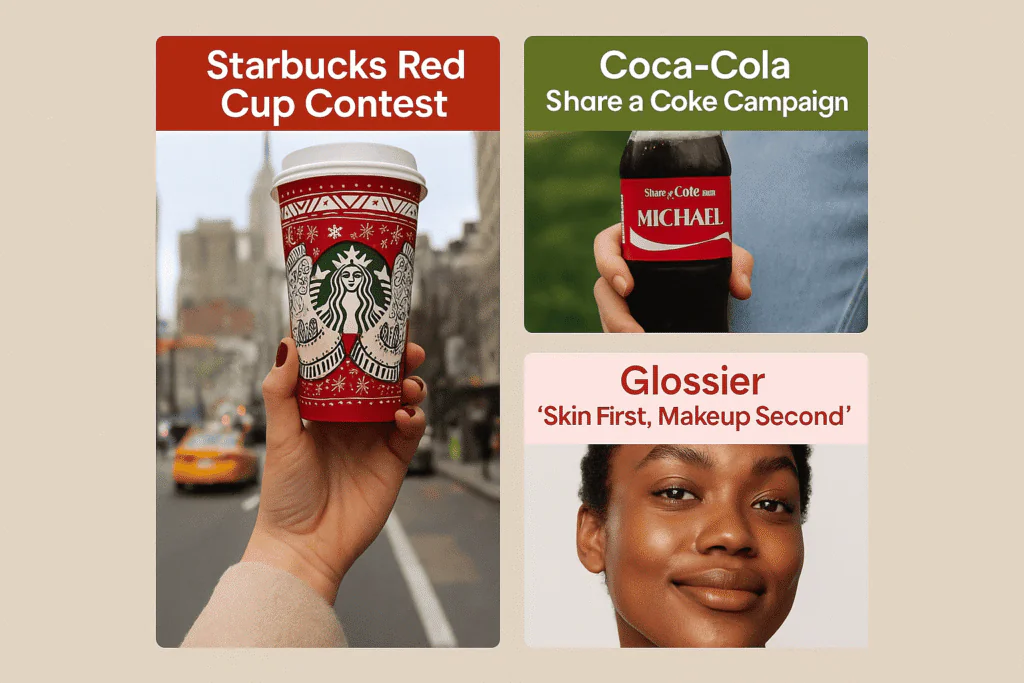
- Starbucks: Runs the annual #RedCupContest each holiday season, inviting customers to share creative red cup photos. In 2022, it generated 40,000+ tagged posts on Instagram, boosting brand love and social media presence.
- Coca-Cola: Their #ShareACoke campaign launched in 80+ countries. It encouraged people to post bottles with their names. The result? User-Generated Content grew by 870% in year one, strengthening Coca-Cola’s social media presence worldwide.
- Glossier: Their “skin first, makeup second” approach features real customers, reposting unfiltered selfies and reviews. This built stronger engagement and trust, proving UGC keeps a brand’s social media presence authentic.
How to Apply UGC in Your Brand:
- Ask customers to tag you in photos or use a custom hashtag.
- Feature their content on your stories or main feed (with credit)
These steps prove that User-Generated Content fuels authenticity and strengthens a strong social media presence.
Tips for Humanizing Your Brand
- Respond to every comment, especially the thoughtful ones.
- Use first names in DMs or comments where possible
- Share behind-the-scenes moments
- Keep your brand voice casual and human
- Celebrate followers, thank them, and repost their content
Mistakes to Avoid
- Ignoring DMs and comments, especially negative feedback.
- Using generic copy-paste replies
- Turning off comments unless needed
- Posting social content that doesn’t invite interaction.
Your goal is to build real relationships, not just a social media follower count. That’s how your social media presence earns trust and loyalty.
Step 5: Use Tools to Manage & Scale your Social Media Presence
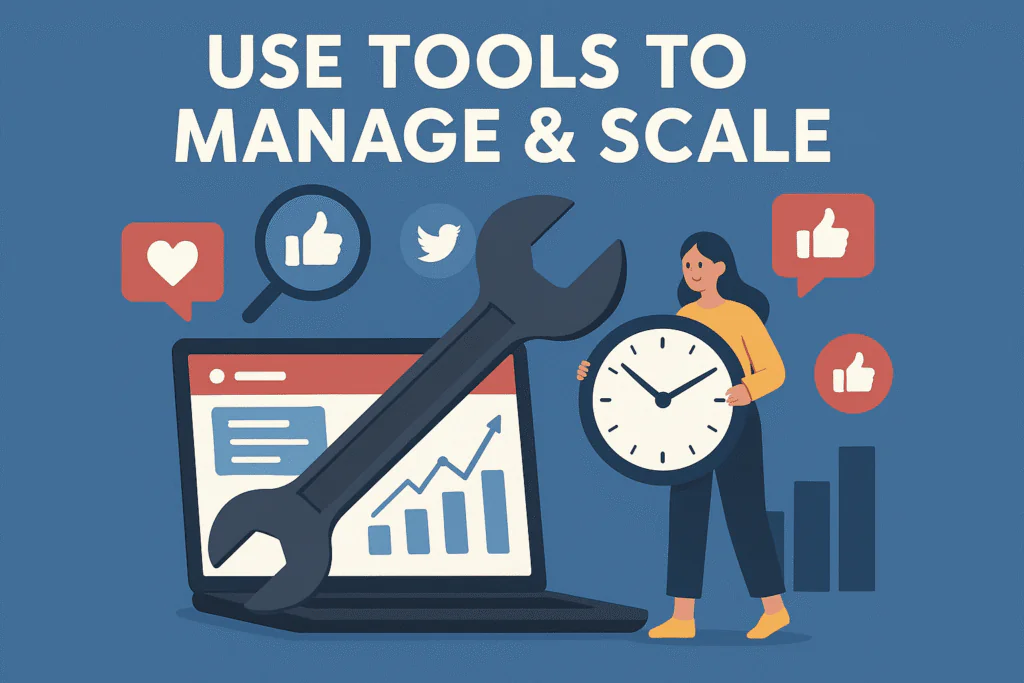
Why Small Businesses Need the Right Tool Stack and Increase their Social Media Presence
Manual posting works at first, but scaling a social media presence takes time and energy. Tools help organize, save resources, and let small businesses compete with larger brands.
The right tools handle content scheduling, track results with analytics, reply through a social inbox, and reveal what your audience wants. This keeps your social media presence steady.
Balance Automation with Human Touch
Automation in social media saves time, while human replies build trust.
Automate these:
- Scheduling and publishing content.
- Recycling evergreen posts.
- Collecting Evergreen content
Keep personal:
- Responding to DMs and comments.
- Engaging in Stories or Lives
- Sharing trending updates on social media.
This balance makes your social media presence authentic and scalable.
RecurPost for Smarter Social Media Scheduling
Posting steadily is key to building trust and strengthening social media presence, but posting daily by hand wastes time. RecurPost helps by:
- Scheduling across social platforms
- Recycling evergreen posts
- Suggesting the best posting times
- Keeping feeds active while you run your business
What Metrics Should You Track? (Analytics 101)
Don’t just post, measure too. Here are key performance indicators (KPIs) that tell you what’s working:
| Metric | What It Tells You |
| Engagement rate | How well your audience is interacting |
| Share of voice | How often is your brand mentioned vs. others |
| Click-through rate (CTR) | How many people click your links |
| Conversions | How many actions (sales, signups) result from posts |
RecurPost + Google Analytics gives full dashboards to measure social media presence.
Recommended Tech Stack for Small Teams to Increase Their Social Media Presence
Below is a curated list of top tools categorized by purpose, helping you choose the best fit for your team size, goals, and workflow to strengthen your social media presence.
| Category | Tool Options | Primary Use Case |
| Content Scheduling | RecurPost, Buffer, Later, Planoly, Hootsuite | Plan, publish, and recycle posts across platforms |
| Visual Design & Graphics | Canva, Adobe Express, VistaCreate, Figma | Create branded graphics, posts, and templates |
| Video Creation | CapCut, InShot, Adobe Premiere Rush, Animoto | Produce short videos, tutorials, or product reels |
| Analytics & Performance | RecurPost Analytics, Google Analytics, Sprout Social, Meta Business Suite | Track engagement, reach, conversions, and audience behavior |
| Hashtag Research | Hashtagify, RiteTag, Flick | Find relevant hashtags and measure their performance |
| Social Listening & Monitoring | Brand24, Meltwater, Hootsuite Streams, Sprout Listening, Mention | Monitor brand mentions, keywords, and sentiment |
| Content Planning & Calendars | Notion, Trello, Airtable, Google Calendar | Organize content strategy and weekly/monthly planning |
| AI Content Assistance | ChatGPT, Jasper, Copy.ai | Generate ideas, captions, and draft content faster |
| DM & Comment Management | RecurPost Inbox, Sprout Social, AgoraPulse, Zoho Social | Centralized reply to DMs, mentions, and comments |
| Link Tracking & Shortening | Bitly, Rebrandly, UTM Builder Tools | Shorten links, track clicks, and set up UTM parameters |
| Influencer Collaboration | Upfluence, AspireIQ, Creator.co | Discover, connect, and manage partnerships with influencers |
Step 6: Measure, Learn, and Improve Social Media Presence
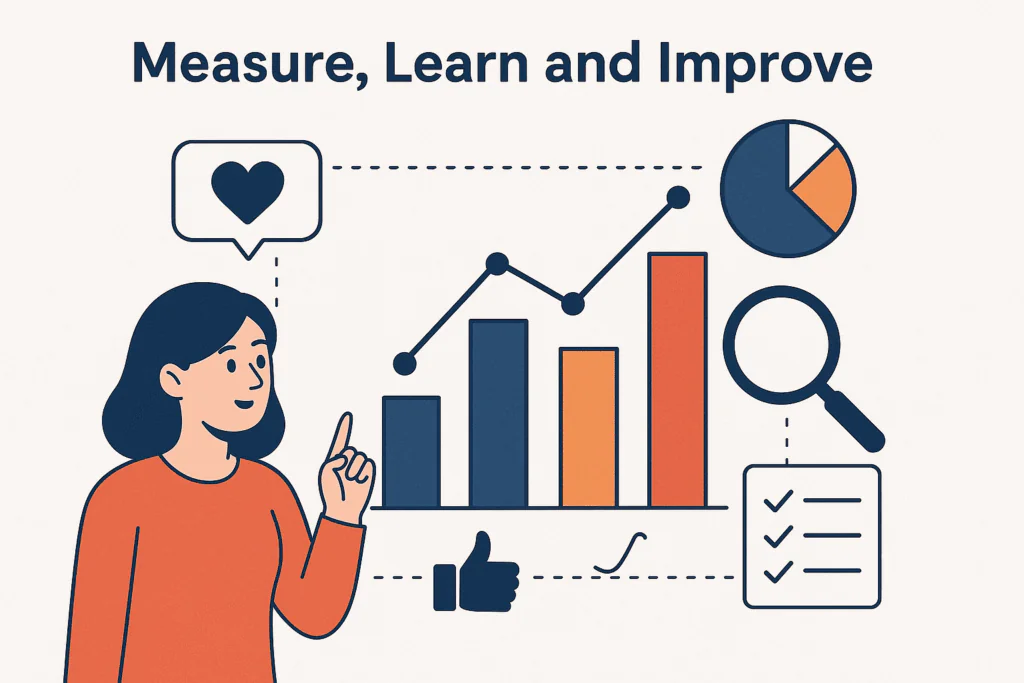
Why Tracking Matters
A strong social media presence grows through steady tracking, smart time investment, and analytics insights.
Performance tracking of social media helps businesses:
- Drop weak social content
- Double down on posts that raise engagement and conversions
- Understand their audience and sharpen brand voice
Metrics That Matter Most on Social Media
Here’s what to keep an eye on for Increasing Your Social Media Presence(and why it matters):
| Metric | What It Tells You |
| Engagement Rate | Are people interacting with your content (likes, comments, shares)? |
| Reach & Impressions | How far and how often is content seen? |
| Click-Through Rate | Are users clicking on your links or CTAs? |
| Follower Growth | Is your audience growing steadily? |
| Conversions | Are posts driving sales, signups, downloads? |
| Share of Voice | Mentions compared to competitors |
Tracking these keeps your social media presence accountable.
Use RecurPost, Google Analytics, and platform dashboards (Meta, LinkedIn, YouTube) to gather and compare results for your social media presence.
Monthly Audit Checklist
At the end of each month, review your results to see what’s working for your social media presence:
Option 2 — Concise & direct
At month-end, review the metrics that show your social media presence performance:
- Review the top and worst-performing posts
- Track best posting days/times
- Monitor follower growth
- Measure referral traffic to your site
- Check conversion rate per campaign
These steps refine your content calendar and strengthen future posts.
Turn Insights Into Action
Data collection informs these actions:
- Post more of what sparks engagement
- Test underused formats (Stories, Reels)
- Retire weak social content types
- Align your calendar with audience insights
Data turns into stronger actions that boost your social media presence.
Common Mistakes to Avoid
- Ignoring analytics tracking
- Focusing only on vanity metrics (likes, followers) without looking at engagement or conversions.
- Not setting clear goals before measuring.
- Using scattered tools with no central dashboard
Tips From Top Brands
Here’s a look at how both small and big brands are creating winning social media strategies and what you can learn from them.
Small Brand: Beardbrand
- Platform Focus: YouTube and Instagram
- What They Do: Grooming tips, founder stories.
- Takeaway for Small Businesses: Teach your niche, stay authentic.
Big Brand: Wendy’s
- Platform Focus: Twitter (X)
- What They Do: Witty, real-time interactions with customers and competitors. They’ve turned sass into a signature voice.
- Takeaway: A bold, steady voice makes you stand out on social media.
Big Brand: Airbnb
- Platform Focus: Instagram and YouTube
- What They Do: Post stories from hosts and travelers around the world.
- Takeaway: User-generated content and storytelling build trust and loyalty.
Extra Tools & Resources Worth Exploring
- AnswerThePublic – Find trending questions your audience is asking.
- BuzzSumo – Discover high-performing content in your industry.
- SparkToro – Identify where your audience hangs out online.
- Social Media Examiner – Latest tips, updates, and tutorials.
Now you’re equipped not just with a plan, but with proof that your social media presence truly works..
Now you’re equipped not just with a plan, but with proof that it works.
These 6 steps build a strong, steady social media presence for solopreneurs, startups, and growing brands. Success comes from:
- Using analytics tracking to guide actions.
- Starting small and staying consistent
- Prioritizing engagement habits over vanity metrics
Conclusion: What We’ve Learned and Why It Matters
A strong social media presence starts with clarity: brand voice, visual identity, and steady social content. A defined identity builds trust and recognition.
Success requires smart platform choices. Concentrate on 1–2 platforms where your audience is active instead of spreading your media presence thin.
Use a content calendar to avoid random posting. A steady rhythm reduces stress, strengthens your digital footprint, and brings clear results.
Strong engagement habits build trust. Replying to comments, sharing User Generated Content, and showing humanity turn followers into loyal fans. That’s how your social media presence earns lasting impact.
Tools for scheduling, content recycling, and analytics tracking scale your social media presence while saving time. Data shows what works and prevents wasted effort.
A strong social media presence requires brand clarity, audience care, and purposeful actions. Each follower, post, and reply shapes your digital persona and reputation over time.
Frequently Asked Questions
1. How can I take stock of my current social media presence?
Start with a social media audit. List every active and inactive profile in a spreadsheet. Note follower counts, posting schedule, engagement rate, and recent posts. Tools like RecurPost, Sprout Social, or Hootsuite give templates and analytics. This shows what’s working, where you’re slipping, and which platforms strengthen your social media presence.
2. Which social media platforms should my business focus on?
Choose 1–2 platforms where your target audience spends time.
For example:
–Instagram/TikTok for lifestyle or B2C Brands
-LinkedIn, if you’re B2B
-Facebook for local services and community engagement
Less is more; Too many channels weaken your social media presence.
3. What content themes drive meaningful engagement on social media?
Use a mix of four content types:
–Educational (how-tos, case studies)
-Entertaining (memes, quizzes)
-Promotional (product launches, offers)
-Community-based (user-generated content, testimonials)
This balance builds trust, engagement, and a stronger social media presence.
4. How often should I post on Instagram, Facebook, LinkedIn, TikTok, or YouTube?
Recommended frequencies:
-Instagram: 3–5 posts/week (+ daily Stories)
-Facebook: 3–4 posts/week
-LinkedIn: 2–3 posts/week
-TikTok: 4–7 short videos/week
-YouTube: 1 video/week
Pick a schedule you can stick to; consistency matters more than volume.
5. How do I define my brand voice and visual identity for social media?
Brand voice is how your business speaks: casual, formal, witty, or bold. Choose 3 guiding words (e.g., “friendly, confident, simple”) and use them in every post. Visual identity covers colors, fonts, logo placement, photo style, and steady templates. A clear identity makes your social media presence recognizable and trusted.

Fenil Patel makes complex topics simple and useful for readers who want clarity, value, and actionable takeaways. As an SEO content writer with 4+ years of experience, he creates blogs and website content that answer real questions, solve problems, and guide readers toward informed decisions. Whether it’s healthcare, fashion, or SaaS, Fenil’s writing is designed to give you practical insights while ensuring the information you read is trustworthy, engaging, and easy to apply.

